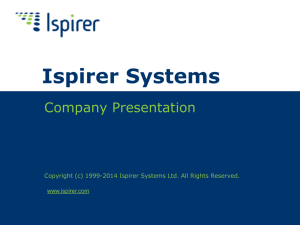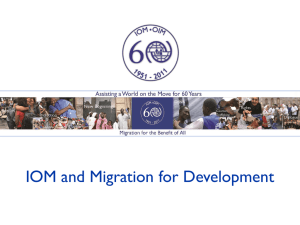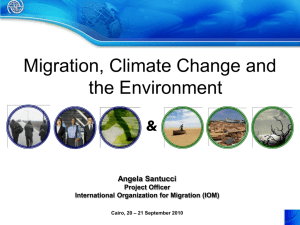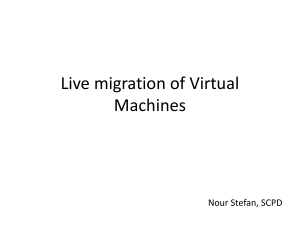View the Presentation
advertisement
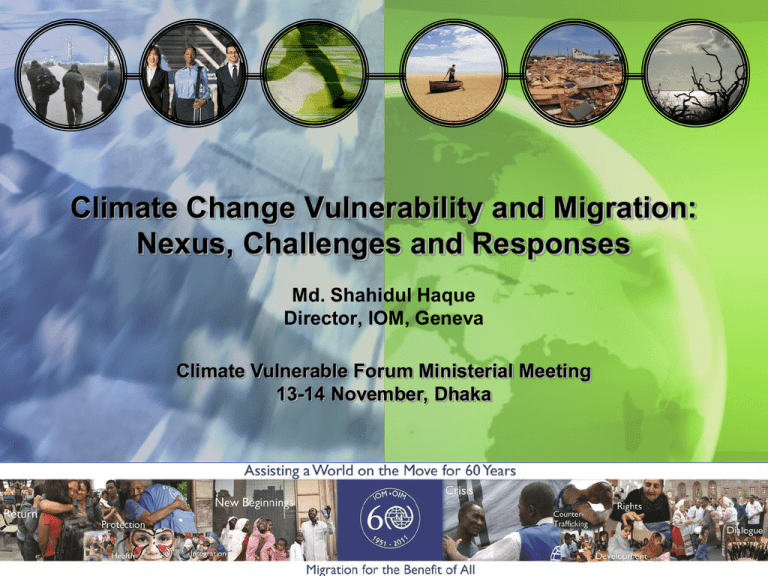
Climate Change Vulnerability and Migration: Nexus, Challenges and Responses Md. Shahidul Haque Director, IOM, Geneva Climate Vulnerable Forum Ministerial Meeting 13-14 November, Dhaka 1 Introduction Vulnerability is highly contextual to geographical, socio-economic, gender and age factors Three ways to look at climate change vulnerability and migration nexus: First: Displacement / forced migration can be a manifestation of climate change vulnerability Second: Mass population flows can create new vulnerabilities for mobile populations, as well as for their communities of origin and destination Third: Migration can also be a strategy to reduce vulnerability to climate change 2 Climate Change Vulnerability and Migration Displacement / forced migration can be a manifestation of climate change vulnerability High exposure to climatic events and processes, combined with low resilience / adaptation capacity leaving no choice but to move Result of lack of alternatives, low levels of development, marginalization, low preparedness… © International Federation of Red Cross and Red Crescent Societies 3 Climate Change Vulnerability and Migration Migration can create new vulnerabilities © IOM 2005 - MPK0049 (Photo: Meral Jabucar) Risks incurred during the movement phase Displacement onto more marginal lands / into hazardous and precarious conditions (e.g. urban slums) Prolonged displacement (e.g. in camps) Protection challenges (uncertainty of status) Challenges for those who stay behind 4 Climate Change Vulnerability and Migration Migration can be a strategy to reduce vulnerability Migration as a survival strategy – “last resort”, in the event of impending or acute natural disaster Migration as an adaptation strategy – manages risks – reduces reliance on the environment for subsistence – allows for livelihood and income diversification Trapped populations vulnerability of those who cannot move 5 © IOM October 2009 Conceptualization A working definition “Environmental migrants are persons or groups of persons who, for compelling reasons of sudden or progressive change in the environment that adversely affects their lives or living conditions, are obliged to leave their habitual homes, or choose to do so, either temporarily or permanently, and who move either within their country or abroad.” IOM 2007 6 Drivers of Environmental Migration Environmental factors: Sudden onset Slow onset Environmental degradation Individual Cultural Social factors Environmental Migration Economic factors Political factors 7 Responses to Environmental Migration Vulnerability Migratory responses: First: Prevent forced migration resulting from environmental factors to the extent possible. Second: Provide assistance and protection to affected populations where forced migration does occur, and to seek durable solution to their situation. Third: Facilitate migration as an adaptation strategy to climate change. 8 Managing Environmental Migration 5. Address longterm challenges: durable solutions, migration, development and adaptation 1. Prevent forced migration, facilitate migration as adaptation 2. Prepare for displacement and relocation 4. Mitigate impacts of forced or mass migration 3. Manage migration: assistance and protection 9 IOM’s Role and Responsibility Policy Policy dialogue (national, regional, international) Focus on coherent and proactive policymaking Research Inter-disciplinary research and publications Links between research and policy communities Operations Humanitarian response to displacement induced by natural disaster / complex emergencies Global cluster lead for Camp Coordination and Management in Natural Disasters Reducing vulnerability and promoting adaptation to environmental and climate change 10 IOM Experience Sea-level rise and gradual environmental change – Sustainable development and climate change adaptation against migration pressures Sudan © IOM 2006 - MSD0247 (Photo: Sunil Srivastava) Mauritius Drought, water scarcity and conflict – Vulnerability mapping for durable solutions to displacement 11 IOM Experience Bangladesh Eastern Africa Cross-border pastoralism, resource scarcity and conflict – Disasters, erosion and sea-level rise – Emergency response, disaster risk reduction and capacity building © Sven Torfinn/IOM 2006 - MSD0142 Ensuring pastoralist livelihoods, enabling adaptation through mobility 12 IOM Experience Haiti Myanmar High vulnerability, low preparedness – Emergency response, urgent health care and shelter assistance for the displaced Degradation and disasters, cumulative vulnerability, complex emergencies – Disaster risk reduction and livelihood stabilization © International Federation of Red Cross and Red Crescent Societies 13 IOM Experience Azerbaijan Water scarcity and migration pressures – © IOM 2009 - MAZ0016 (Photo: Jean Philippe Chauzy) Traditional adaptation strategies to stabilize livelihoods Colombia Environmental vulnerabilities – Adaptation through temporary labour mobility Protecting the most vulnerable – Regional capacity building in disaster risk reduction 14 Way Forward 1. Manage knowledge and improve data 2. Enhance capacities: policy, legal instruments, institutional structure and operational mechanisms 3. Build comprehensive migration policies: migration, adaptation, development, disaster risk management 4. Operationalize migration: as adaptation and disaster risk reduction strategies 5. Mobilize resources: integrated policy development and planning 6. Commit politically at high level: dialogue, partnerships and empowerment of affected people 15 Thank you and Discussion 16



